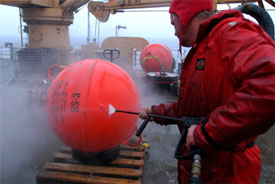 |
 |
 |
| John Kemp scrubs the mooring spheres clean with high pressure water. |
| Click
to enlarge |
Daily Update
Calendar
Dispatch 19 - September 28, 2003
By C. A. Linder
Weather conditions: Fog, 10 kt winds, 1-2 ft seas, air temperature
34°F
Cruising in the Clouds
An intermittent droning woke me up this morning. Sunday mornings are
normally very quiet on the ship, since crewmembers not on watch have
the day off. As I looked out the porthole in my room I immediately
understood - it was the foghorn. I could barely see the horizon; sky
melted into water. As we steamed south, back towards Barrow, we stopped
intermittently for CTD casts.
After lunch, the fog began to break into patches, and as the sun hit
them beautiful fogbows appeared out
of the mist. A fogbow is very similar to a rainbow, except formed
by the fine water droplets in fog instead of raindrops. The colors
of a rainbow are formed by light refracting through the water droplets.
Large drops cause the brightest colors. As the droplets decrease in
size, wave interference causes the colors to overlap. The combination
of colors results in a bright white arc - the fogbow.
While the CTD crew was busy collecting new data, the mooring redeployment preparations continued. John Kemp gave the floats a good scrubbing, taking off layers of sharp barnacles. Marshall Swartz worked on the CTD calibrations, ensuring that the instruments will make accurate measurements when they are deployed. The data analysis also continued.
Here are some excellent questions about our
arctic environment from Mr. Jarvi's 5th grade class at Varnum
Brook Elementary School.
Question:
What is the coldest recorded temperature?
Answer: The lowest recorded temperature on Earth
was measured at Vostock II, Antarctica. The temperature was -128.6°F
on July 21, 1983. Since the Arctic Ocean's climate is moderated by
the ocean, just like Cape Cod, the low temperatures only reach -40°F
to -70°F during an Arctic winter. While this seems pretty cold,
keep in mind that New England can get pretty cold, too... The lowest
recorded temperature on the summit of Mount Washington, New Hampshire
was -47°F - very comparable to the Arctic!
Question: Is it dark out there or light out?
Answer: Right now we are having about the same amount
of daylight and darkness as you are in Pepperell (about 11.5 hours).
The sun rose at 8:13 AM and it set at 7:42 PM. However, every passing
day means less and less daylight - about 9 minutes for us but only
3 minutes for you. By the time we pull into Nome, Alaska on October
19th, we will only have about 9 hours of daylight.
Question: What is the warmest day you have had out there?
Answer: The warmest day we have had was on September
22, when the thermometer hit 37.4°F. The coldest it has
been so far has been 25.4°F. Today it felt quite warm when I
was walking around deck. You know you've been in the Arctic for
a while when 34°F feels warm!
Tonight the sky was aflame with color
as the sun sank below the horizon. We are hoping the old sailors'
adage holds true - "Red sky at night, sailors' delight!"
Keep those great questions coming!
 Previous
Dispatch Next Dispatch Previous
Dispatch Next Dispatch

Back to
Calendar
|




